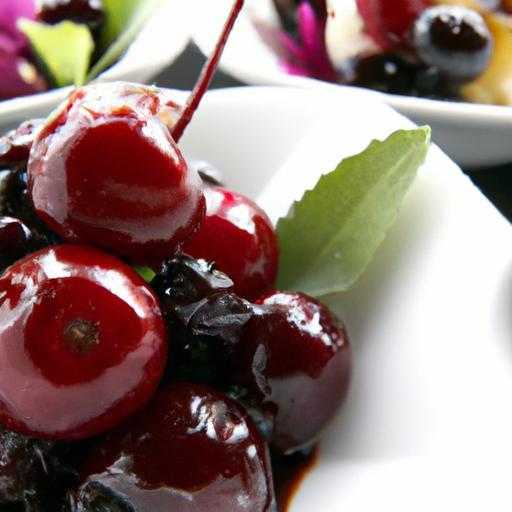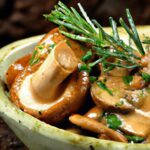Beneath the dappled sunlight of late summer woods, a hidden gem awaits the keen eye and curious palate: the humble chokecherry. These glossy, dark clusters may not boast the sweetness of familiar orchard fruits, but their vibrant tartness tells a story of wild landscapes and ancient traditions. Foraging chokecherries is more than just harvesting fruit-it’s an invitation to connect with nature’s untamed bounty, to learn the art of spotting these often-overlooked treasures, and to transform their puckering punch into jams, syrups, and flavors that celebrate the forest’s rich gifts. Join us as we explore how to safely identify, thoughtfully gather, and creatively savor chokecherries-nature’s tart jewels ready to enliven your next culinary adventure.
Foraging chokecherries unveils not just a culinary adventure but a connection to nature’s vibrant tart treasures. These wild berries offer a tangy burst of flavor that, when carefully harvested and transformed, can elevate your kitchen repertoire. Whether you’re new to foraging or an experienced gatherer, embracing the art of spotting and preparing chokecherries is both rewarding and delicious.
Prep and Cook Time
Preparation: 20 minutes | Cooking: 30 minutes | Total: 50 minutes
Yield
Approximately 4 cups of chokecherry jam (serves 8)
Difficulty Level
Medium – Ideal for adventurous cooks ready to explore wild ingredients
Ingredients
- 4 cups ripe chokecherries, stems and leaves removed
- 1 ½ cups granulated sugar
- 1 tablespoon fresh lemon juice
- ½ cup water
- 1 teaspoon vanilla extract (optional, to soften tartness)
- 1 tablespoon pectin (optional, for thicker jam)
Instructions
- Rinse the chokecherries thoroughly under cold water. Remove stems and any leaves to avoid bitterness.
- Combine chokecherries, water, and lemon juice in a heavy-bottomed saucepan over medium heat. Bring to a gentle boil, then reduce heat and simmer for 15 minutes, mashing berries occasionally to release their juices.
- Strain the mixture through a fine sieve or food mill to separate juice from skins and pits. Use the back of a spoon or a spatula to press down and extract maximum flavor without forcing pits through.
- Return the strained juice to the saucepan. Gradually stir in granulated sugar and pectin (if using), heating over medium again. Stir constantly until sugar dissolves completely and mixture begins to thicken (about 10-15 minutes).
- Remove from heat and stir in vanilla extract if using, for a subtle sweetness that balances the natural tartness of chokecherries.
- Pour the hot jam into sterilized jars, leaving ¼-inch headspace. Seal with sterilized lids and allow to cool to room temperature before refrigerating or storing.
Chef’s Notes
- Selecting berries: Only pick deep crimson to almost black chokecherries, as unripe ones are highly astringent and bitter.
- Pectin alternative: If you don’t have pectin, increase cooking time to reduce liquid for a naturally thicker jam.
- Stone removal tip: Use a cherry pitter where possible or gently press berries before straining to minimize bitterness.
- Preserving: For longer shelf life, process filled jars in a boiling water bath for 10 minutes to seal them.
- Flavor variations: Add a cinnamon stick or star anise during simmering for a warm spice note, removing before jarring.
Serving Suggestions
Serve your homemade chokecherry jam spread generously on warm toast, paired with soft cheeses like brie or goat cheese. It also makes an inspiring topping for pancakes, yogurt bowls, or as a tangy glaze on grilled pork or duck breasts. Garnish with fresh mint leaves or lemon zest to brighten every bite visually and flavor-wise.

| Nutrient | Per 2 tbsp | Daily Value (%) |
|---|---|---|
| Calories | 60 | 3% |
| Protein | 0.2 g | 0.4% |
| Carbohydrates | 15 g | 5% |
| Fat | 0 g | 0% |
Explore More Wild Flavors
Looking to deepen your connection with wild edibles? Check out our Wildberry Foraging Guide for tips on safely harvesting nature’s best. For detailed botanical insights, visit the USDA Forest Service Plant Identification Resources.
Q&A
Foraging Chokecherries: Spot, Harvest, and Savor Nature’s Tart Treasures – Q&A
Q1: What exactly are chokecherries, and why should I bother foraging them?
A1: Chokecherries (Prunus virginiana) are small, dark reddish to black berries that grow wild across much of North America. They’re nature’s little tart gems-brisk, tangy, and packed with antioxidants. Foraging them connects you to the land, adds a zingy twist to your culinary creations, and taps into a tradition that countless cultures have cherished for centuries.
Q2: How can I identify chokecherry bushes in the wild without mistaking them for something harmful?
A2: Look for clusters of shiny, oval leaves with finely serrated edges and smooth red or brown bark on slender branches. The berries grow in tight clusters along long stems and turn from red to a deep purple-black when ripe. Beware of the look-alikes: wild cherry fruits can be similar, but chokecherries have a distinctly tart zing and bitter pits. Always cross-reference with a local foraging guide to be certain!
Q3: When is the best time to forage chokecherries?
A3: Late summer to early fall is prime time-usually August through early September depending on your region. The berries should be fully dark and soft to the touch but not mushy. Overripe chokecherries can be overly bitter or moldy, while underripe ones are painfully astringent, so timing is key to catching that perfect balance of tang and sweetness.
Q4: What’s the best technique for harvesting chokecherries without damaging the plant?
A4: Gently pluck whole clusters of berries rather than pulling individual fruits. Using small scissors or garden shears to snip entire sprigs is even better, preserving the bush’s future productivity. Remember, the goal is to leave plenty behind for wildlife and the plant’s natural propagation-you’re part of a bigger ecosystem!
Q5: Chokecherries are known for their tartness-how can I prepare them to enjoy their unique flavor?
A5: Chokecherries shine in jams, jellies, syrups, and sauces where their tartness can be balanced with sugar. They’re also fantastic dried or turned into a chewy fruit leather. Traditional Native American recipes often incorporate chokecherries into pemmican-a nutrient-dense, energy-packed treat. Just remember: the pits contain trace amounts of cyanide compounds and should never be eaten or ground up.
Q6: Are chokecherries safe to eat raw?
A6: Yes, the flesh is edible raw and often enjoyed fresh by foragers, though the intense tartness can be surprising. The main caution is to avoid crushing or chewing the seeds inside the pit, which contain amygdalin-a compound that can release cyanide. It’s best to spit out or discard pits. Cooking or processing also naturally reduces this risk.
Q7: How can foraging chokecherries deepen my connection to nature?
A7: Foraging invites you to slow down, observe seasonal rhythms, and tune into the whispers of local ecosystems. Picking chokecherries connects you to indigenous traditions and countless generations who relied on wild foods. Through this mindful act, you become a steward of the land, appreciating not just the bounty but the delicate balance of nature’s cycles.
Q8: What are some ecological benefits of leaving some chokecherries on the bush?
A8: The berries feed birds, bears, and small mammals, helping to sustain local wildlife populations. Leaving some fruit also helps the plant spread naturally-animals disperse the seeds in their droppings, allowing new bushes to grow. Responsible foraging means taking only what you need and supporting a healthy, thriving environment.
Turn your next nature walk into a flavorful adventure-spot those glossy clusters, harvest with care, and savor the sharp, sweet taste of chokecherries. Nature’s tart treasures await!
Wrapping Up
As the sun dips low and the wild chokecherry bushes sway gently in the breeze, you’ll find yourself richer-not just in handpicked berries, but in experience, connection, and a taste of untamed nature’s bounty. Foraging chokecherries invites you to slow down, observe, and engage with the landscape in a deeply meaningful way. With every tart bite or delicious jam, you celebrate the rewards of mindful harvesting and the age-old tradition of turning wild treasures into cherished flavors. So next time you venture outdoors, keep an eye out for those glossy, dark clusters, and savor the journey from spot to harvest to table, where nature’s tart gems become stories on your tongue and memories in your heart.


